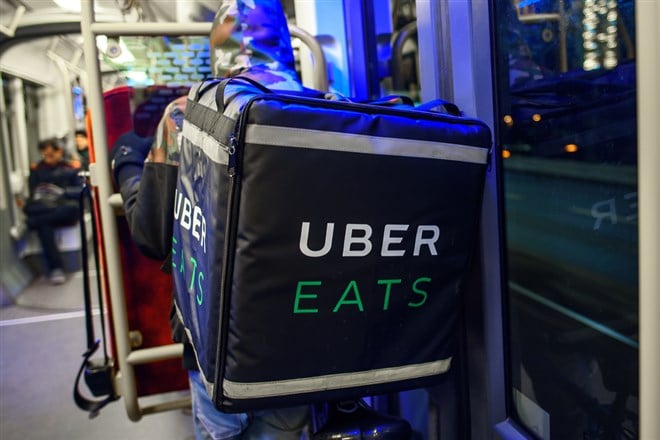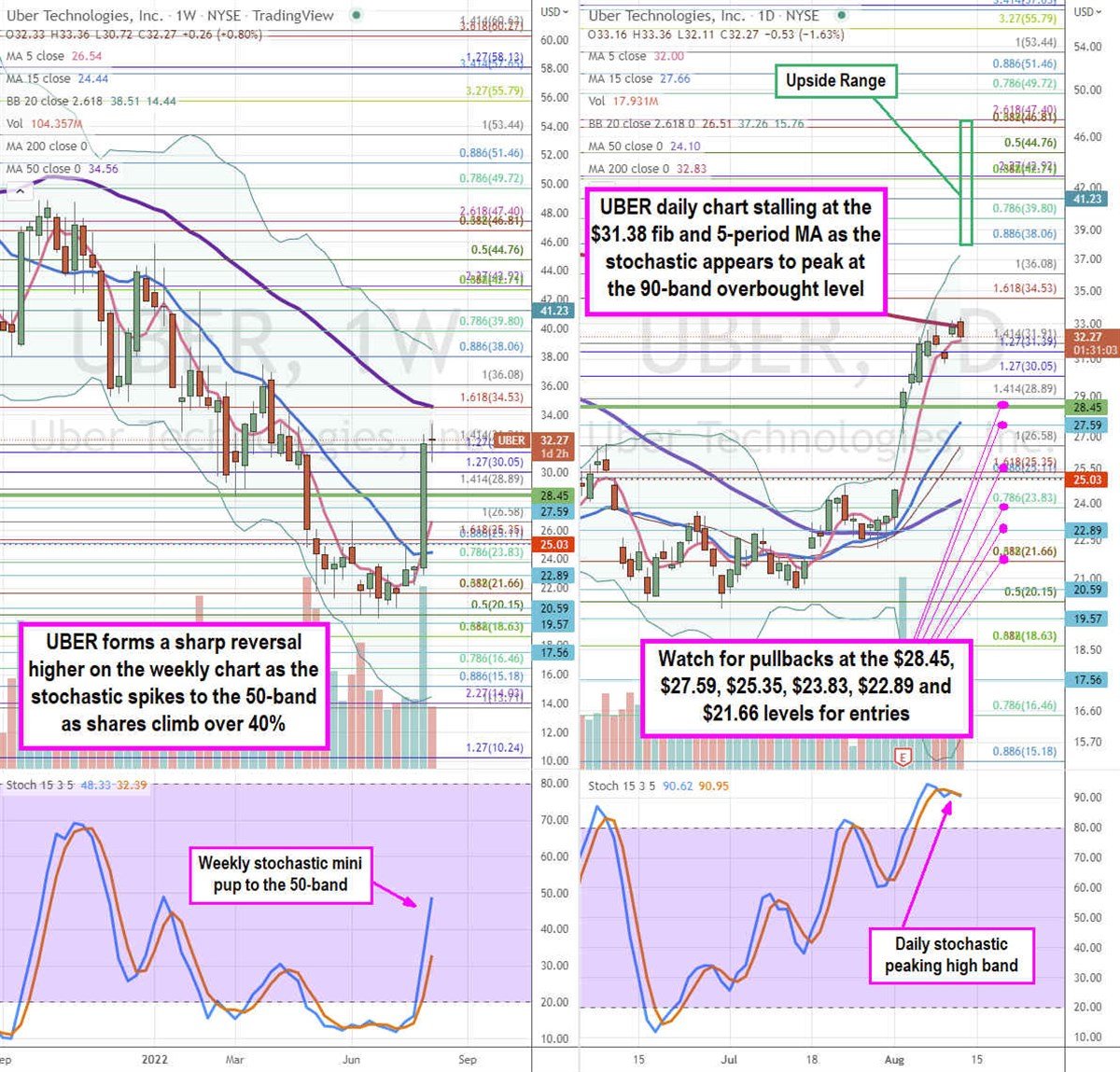
Rideshare and delivery giant Uber (NASDAQ: UBER) has seen its stock rally over 50% off its lows but is still down (-26%) on the year. The nation’s largest rideshare network continues to lose money despite seeing its sales rebound sharply. From a fundamental view, Uber has been a mind-boggling money pit that has blown through billions of investor dollars. However, it’s also become a part of the English slang as a verb describing an ever on-demand culture where products and services can be quickly and conveniently ordered wherever and whenever desired at the tap of a smartphone. The CEO has stated that the Company is focusing on profitability over growth and technically they did hit adjusted profits, which Wall Street took as great news shooting the stock up nearly 30% in a week. For optimists, the Company is improving and expanding. It’s recent partnerships grew to include Disney+ (NYSE: DIS) offering Uber Eats customers two free months of the Disney Bundle along with taxi companies like IT Taxi in Italy, and the electric vehicle (EV) partnership with Hertz (NYSE: HTZ) for drivers to lease Tesla (NASDAQ: TSLA) EVs to provide rides. Riders can testify to paying more now for Uber rides than they did pre-pandemic.
You can’t charge 50-cents for a $5 hamburger forever, just long enough to kill off the competition, grow market share and get them addicted… then incrementally jack up the prices. Some call that bait-n-switch, but Wall Street approves. That’s been Uber’s game plan all along, and it’s playing out masterfully.
Two Businesses in One
Uber has two main business segments: rideshare and food and grocery delivery. It’s like getting two stocks in one. The rideshare network was the main business pre-pandemic which competes with distant competitors in the duopoly Lyft (NASDAQ: LYFT). It’s Uber Eats, and Post Mates delivery business competes with DoorDash (NASDAQ: DASH). The common theme behind these business models is the buildout of a network infrastructure. The mobility business grew 55% in the fiscal second quarter and finally surpassed the delivery business in terms of revenues. This was impressive considering that the delivery included revenues from Postmates, which was acquired during the pandemic in November 2020 for $2.5 billion in stock. Owning Uber stock is literally owning a piece of three businesses that also share a transportation and distribution network to harness the network effect.
Path to Profitability or Money Pit or BOTH?
In its latest fiscal Q2 2022 results, Uber reported a GAAP earnings-per-share (EPS) loss of (-$1.33) versus consensus analyst estimates for a loss of (-$0.27), missing estimates by (-$1.06). The net loss was (-$2.6 billion) which included $1.7 billion in unrealized losses on their Aurora, Grab (NASDAQ: GRAB), and Zomato stakes. An additional (-$470 million) was attributed to stock-based compensation, up from (-$272 million) in year ago period. The freight bookings spiked from the acquisition of Transplace on Nov. 12, 2021. The remaining losses after the $2.17 billion investment and stock-based compensation result in a (-$430 million) in operating losses. Adjusted EBITDA was $364 million, up $873 million YoY. Adjusted EBITDA excludes recurring non-cash charges, restricting and related charges, stock-based compensation expense, COVID-19 response initiatives, period to period tax changes, certain legal, tax, and regulatory reserve changes and settlements that may reduce cash. Revenues rose 105.6% year-over-year (YoY) to $8.08 billion versus $7.37 billion consensus estimates.
Impressive Snap Back in Mobility Bookings
Gross bookings grew 33% YoY to $29.1 billion comprised of $13.4 billion in mobility up 55% YoY and $13.9 billion in delivery up 7% YoY. The recovery in mobility which includes rideshare and rentals truly stands out as traffic returns to roads. Uber turned a profit on an adjusted EBITDA basis, but in reality, still lost a ton of money. The Company generated $382 million in free cash flow and ended the quarter with $4.4 billion in cash and cash equivalents. The path to profitability is to keep trimming the losses and growing the bookings along with its take rate, which is how much they keep from the bookings.
What’s Expected Next Quarter
Uber provided fiscal Q3 2022 guidance metrics. They expect gross bookings between $29 billion to $30 billion, and adjusted EBITDA around $440 million to $470 million. Uber CEO Dara Khosrowshahi painted the narrative, “Last quarter I challenged our team to meet our profitability commitments even faster than planned—and they delivered. Importantly, they delivered balanced growth: Gross Bookings up 36 percent to a $116 billion run-rate, Adjusted EBITDA significantly above our guidance, and $382 million in free cash flow, all on a platform that’s larger than ever, with the number of consumers and earners using Uber now both at all-time highs.”

Here’s What the Chart Says
We analyze UBER using the rifle charts on both weekly and daily candlestick charts to get near-term interpretation of its price action. The weekly rifle chart bottomed near the $20.15 Fibonacci (fib) level before shares staged a rally through the daily 200-period moving average (MA) at $32.83. The weekly rifle chart triggered a breakout as the 5-period MA at $26.54 crossed up through the 15-period MA at $24.44. The weekly 50-period MA overlaps the $34.53 fib level. The weekly market structure low (MSL) buy triggered above $28.45. The weekly stochastic went from the oversold 10-band to the 50-band on a mini pup as it continues to rise. The daily rifle chart uptrend is slowing as the 5-period MA support sits at $32 with the 15-period MA rising at $27.66. The daily stochastic is overbought as it peaks above the 90-band. For investors seeking to build a position in Uber, keep an eye on opportunistic pullback levels at the $28.45 weekly MSL trigger, $27.59, $25.35 fib, $23.83 fib, $22.89, and the $21.66 fib level. Upside price targets range from the $38.06 fib up towards the $47.40 fib level.













